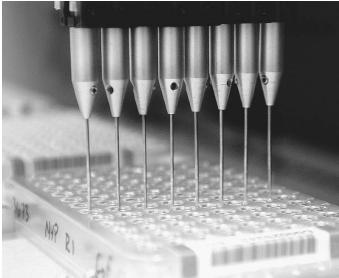Combinatorial Chemistry
Combinatorial chemistry is a sophisticated set of techniques used to synthesize, purify, analyze, and screen large numbers of chemical compounds, far faster and cheaper than was previously possible. The direct precursor of combinatorial chemistry was the solid-phase synthesis of polypeptides developed by American biochemist Robert Bruce Merrifield in the 1960s, followed by the advances in laboratory automation since then. Initial development of the field has been led by the pharmaceutical industry in the search for new drugs, but its applications are spreading into other fields of chemistry. Other terms associated with this field are parallel array synthesis and high-throughput chemistry.
Whereas classical synthetic chemistry involves the stepwise synthesis and purification of a single compound at a time, combinatorial chemistry makes it possible to synthesize thousands of different molecules in a relatively short amount of time, usually without the intermediate separation of compounds involved in the synthetic pathway, and with a high degree of automation. Such procedures result in the production of new compounds faster and in greater numbers than is possible with standard synthetic methods. The first and still the most common type of combinatorial synthesis involves attaching a molecular species onto a macroscopic substrate such as a plastic bead and performing one or several well-characterized chemical reactions on the species. After each reaction, the product mixture can be split among several reaction containers and then recombined after the reaction (a procedure called mix and split ), or else carried out in parallel containers. The resulting mixture of compounds is referred to as a molecular library and can contain many thousands of individual compounds. The analysis, or screening , of these libraries to identify the compounds of interest, along with their subsequent isolation and identification, can be completed by a variety of methods. One example is iterative deconvolution ; it involves the successive identification of each of the units backward along the chain of synthesized units. Another, called positional scanning , requires the multiple synthesis of a library, each time varying the location of a known unit along the chain and comparing the activities of the resulting libraries. More recent advances in library screening involve the "tagging" of a substrate with tiny radio frequency transmitters or unique two-dimensional barcodes. Another important recent advance by researchers allows combinatorial syntheses to be carried out in solution, which further extends the scope and utility of this field.

Although the initial applications of combinatorial and high-throughput chemistry have occurred in the pharmaceutical field, the same techniques are now being used successfully to aid in the discovery of new catalysts, polymers, and high temperature superconductors.
SEE ALSO Chemical Informatics .
Bartow Culp
Bibliography
Fenniri, H. (2000). Combinatorial Chemistry: A Practical Approach. New York: Oxford University Press.
Terrett, N. K. (1998). Combinatorial Chemistry. New York: Oxford University Press.
Comment about this article, ask questions, or add new information about this topic: